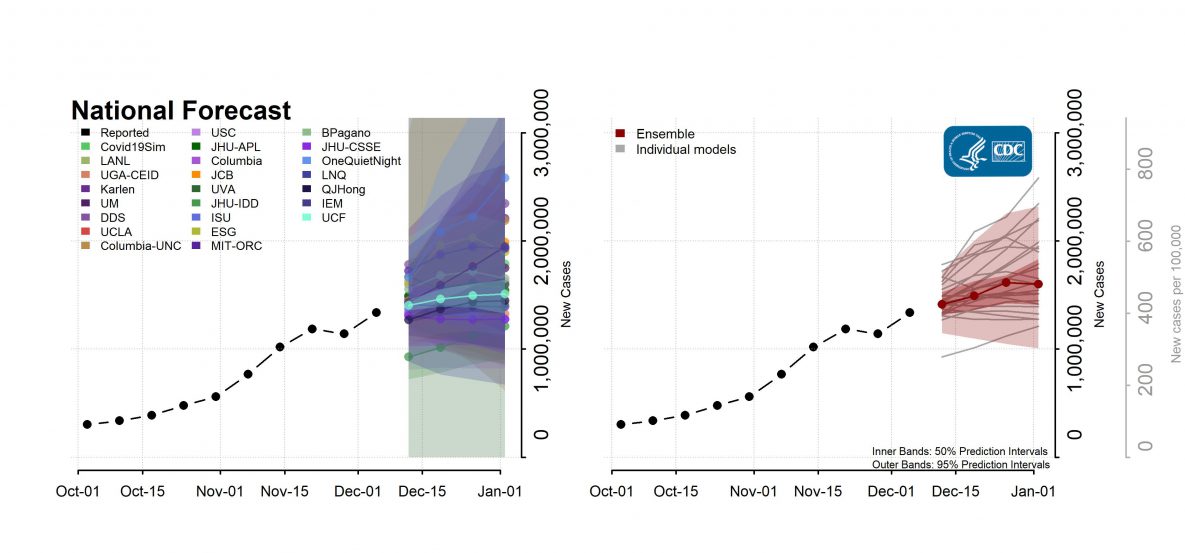IEM’s COVID-19 Predictive Model Now Included in the CDC’s National Ensemble

IEM, the world’s largest woman-owned disaster management firm, now has their IEM Health COVID-19 predictive modeling included in the Center for Disease Control’s (CDC) national forecast ensembles, predicting new COVID-19 cases over the next four weeks. This week the CDC’s national ensemble (https://www.cdc.gov/coronavirus/2019-ncov/cases-updates/forecasts-cases.html and above) predicts that 1,000,000 to 2,300,000 new cases will likely be reported during the week ending January 2, 2021.
The CDC receives forecasts weekly from a variety of modeling groups and combines them to generate national and state ensemble forecasts for new COVID-19 cases, cumulative and incident COVID-19 deaths, and incident COVID-19 hospitalizations four weeks into the future.
The goal of the forecasts and data repository is to create a standardized set of modeling data from teams across the country making projections of cumulative and incident deaths and incident hospitalizations due to COVID-19 in the United States. This project to collect, standardize, visualize, and synthesize forecast data is led by the CDC-funded University of Massachusetts-Amherst’s Influenza Forecasting Center of Excellence, with contributions from IEM and many others.
To be included in the ensemble modeling groups must meet specific criteria and data quality requirements. Currently, 30 groups are included in the forecast of new reported cases. IEM Health’s modeling group uses all the actual data of confirmed cases and utilizes artificial intelligence (AI) to find the right parameter values that best fit the actual data. IEM Health’s model does not assume the average number of secondary infections (R-value) stays the same over time, rather our AI-based model finds the best R-value over time to evaluate how it changes over the course of the pandemic. IEM’s AI process executes approximately four (4) million simulations per jurisdiction to find the best parameter values for a disease model to fit the data and then projects the future number of cases. The future projections are like a hurricane spaghetti plot with thousands of possible paths, and IEM uses the maximum likelihood of all these projections to make the best projection of future cases. Our projections have generally been within five (5) to ten (10) percent of actual cases in the shorter time window (seven days).
“IEM Health is excited for our models to be added to the CDC forecasts, and I am grateful to be supported by a team our team including Brad Suchoski and Dr. Heidi Gurung who are instrumental in producing the IEM Health COVID-19 projections for the CDC ensemble forecast.” said IEM’s lead modeler and Senior Scientist, Dr. Prasith “Sid” Baccam.
IEM’s CEO noted that “In contributing to CDC’s national and state ensemble forecasts, IEM is helping public health professionals and analysts develop a generally agreed upon forecast across the numerous models available. The ensemble also allows individuals to develop a more thorough understanding of the underlying uncertainty and the range of projections generated by models built on different assumptions.”
IEM has been providing their daily models to state and local emergency managers and public health officials pro bono since late March and created a web-based dashboard for their projections (https://www.iem-modeling.com/) during the summer. Earlier this year, Dr. Baccam was recognized by TIME Magazine for his work developing biological planning, modeling and testing post-9/11 that South Korea utilized to develop their successful COVID-19 testing centers. IEM Health’s AI-based COVID-19 Modeling received a Washington Technology “2020 Industry Innovator Award” and was recognized as a transformative technology driving change across the public sector.




